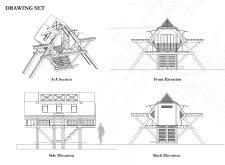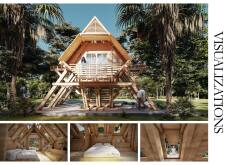5 key facts about this project
The primary function of The Ferret as a hideout is to provide an intimate space for relaxation and interaction with nature. Its design incorporates various essential areas, including a living space, kitchen, sleeping quarters, and a bathroom, all organized to facilitate a seamless indoor-outdoor connection. The elevated structure limits the environmental impact and adapts to the local climate, ensuring durability and comfort.
The project stands out due to its modular construction approach. Each component is designed for ease of assembly or disassembly, making it suitable for remote locations. The use of stilt-like structures enhances the hut’s visibility and provides protection from potential flooding, a consideration for the region’s tropical climate. The design employs local materials, such as laminated veneer lumber for the structural elements and composite wood panels for flooring, which not only add to the aesthetic appeal but also support sustainability.
A unique aspect of The Ferret is its integration of traditional Cambodian architectural forms with contemporary design practices. The sloped gable roof draws parallels to local vernacular, while the expansive glass windows facilitate natural light and views of the exterior landscape. This combination of old and new offers a modern interpretation of respite that respects cultural heritage.
Additionally, the layout promotes an open floor plan that fosters social interaction while providing retreat-like privacy in the sleeping areas. Outdoor terraces extend the living space, encouraging users to engage with nature through activities such as dining and relaxation.
For those seeking a greater understanding of The Ferret, exploring detailed architectural plans, sections, and designs will provide clearer insights into its operational dynamics and innovative solutions. Investigating the architectural ideas behind this project can reveal much about its approach to sustainability, materiality, and integration into the Cambodian environment.


























